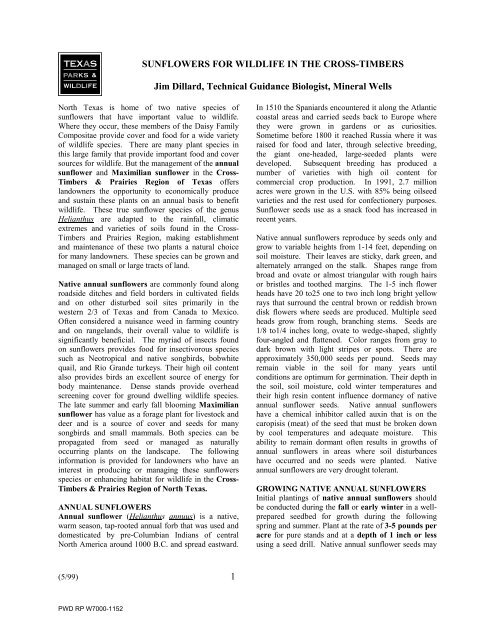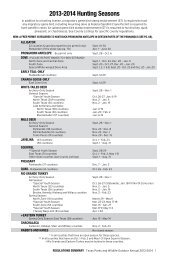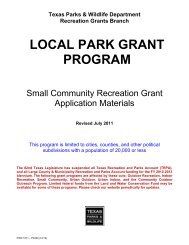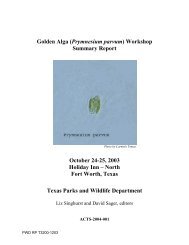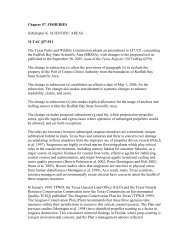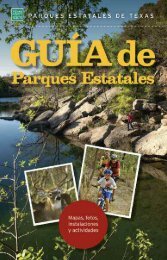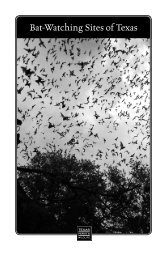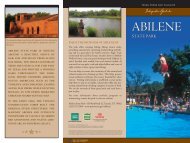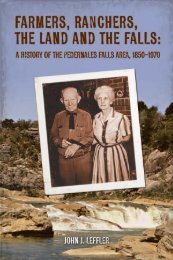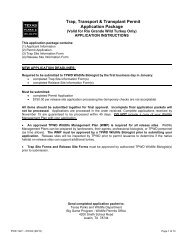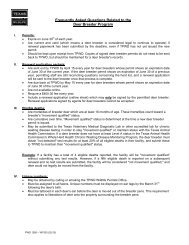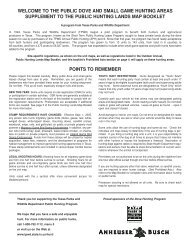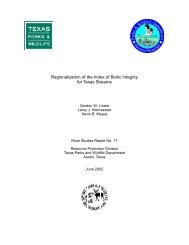Sunflowers for Wildlife in the Cross-timbers - Texas Parks & Wildlife ...
Sunflowers for Wildlife in the Cross-timbers - Texas Parks & Wildlife ...
Sunflowers for Wildlife in the Cross-timbers - Texas Parks & Wildlife ...
You also want an ePaper? Increase the reach of your titles
YUMPU automatically turns print PDFs into web optimized ePapers that Google loves.
SUNFLOWERS FOR WILDLIFE IN THE CROSS-TIMBERS<br />
Jim Dillard, Technical Guidance Biologist, M<strong>in</strong>eral Wells<br />
North <strong>Texas</strong> is home of two native species of<br />
sunflowers that have important value to wildlife.<br />
Where <strong>the</strong>y occur, <strong>the</strong>se members of <strong>the</strong> Daisy Family<br />
Compositae provide cover and food <strong>for</strong> a wide variety<br />
of wildlife species. There are many plant species <strong>in</strong><br />
this large family that provide important food and cover<br />
sources <strong>for</strong> wildlife. But <strong>the</strong> management of <strong>the</strong> annual<br />
sunflower and Maximilian sunflower <strong>in</strong> <strong>the</strong> <strong>Cross</strong>-<br />
Timbers & Prairies Region of <strong>Texas</strong> offers<br />
landowners <strong>the</strong> opportunity to economically produce<br />
and susta<strong>in</strong> <strong>the</strong>se plants on an annual basis to benefit<br />
wildlife. These true sunflower species of <strong>the</strong> genus<br />
Helianthus are adapted to <strong>the</strong> ra<strong>in</strong>fall, climatic<br />
extremes and varieties of soils found <strong>in</strong> <strong>the</strong> <strong>Cross</strong>-<br />
Timbers and Prairies Region, mak<strong>in</strong>g establishment<br />
and ma<strong>in</strong>tenance of <strong>the</strong>se two plants a natural choice<br />
<strong>for</strong> many landowners. These species can be grown and<br />
managed on small or large tracts of land.<br />
Native annual sunflowers are commonly found along<br />
roadside ditches and field borders <strong>in</strong> cultivated fields<br />
and on o<strong>the</strong>r disturbed soil sites primarily <strong>in</strong> <strong>the</strong><br />
western 2/3 of <strong>Texas</strong> and from Canada to Mexico.<br />
Often considered a nuisance weed <strong>in</strong> farm<strong>in</strong>g country<br />
and on rangelands, <strong>the</strong>ir overall value to wildlife is<br />
significantly beneficial. The myriad of <strong>in</strong>sects found<br />
on sunflowers provides food <strong>for</strong> <strong>in</strong>sectivorous species<br />
such as Neotropical and native songbirds, bobwhite<br />
quail, and Rio Grande turkeys. Their high oil content<br />
also provides birds an excellent source of energy <strong>for</strong><br />
body ma<strong>in</strong>tenance. Dense stands provide overhead<br />
screen<strong>in</strong>g cover <strong>for</strong> ground dwell<strong>in</strong>g wildlife species.<br />
The late summer and early fall bloom<strong>in</strong>g Maximilian<br />
sunflower has value as a <strong>for</strong>age plant <strong>for</strong> livestock and<br />
deer and is a source of cover and seeds <strong>for</strong> many<br />
songbirds and small mammals. Both species can be<br />
propagated from seed or managed as naturally<br />
occurr<strong>in</strong>g plants on <strong>the</strong> landscape. The follow<strong>in</strong>g<br />
<strong>in</strong><strong>for</strong>mation is provided <strong>for</strong> landowners who have an<br />
<strong>in</strong>terest <strong>in</strong> produc<strong>in</strong>g or manag<strong>in</strong>g <strong>the</strong>se sunflowers<br />
species or enhanc<strong>in</strong>g habitat <strong>for</strong> wildlife <strong>in</strong> <strong>the</strong> <strong>Cross</strong>-<br />
Timbers & Prairies Region of North <strong>Texas</strong>.<br />
ANNUAL SUNFLOWERS<br />
Annual sunflower (Helianthus annuus) is a native,<br />
warm season, tap-rooted annual <strong>for</strong>b that was used and<br />
domesticated by pre-Columbian Indians of central<br />
North America around 1000 B.C. and spread eastward.<br />
In 1510 <strong>the</strong> Spaniards encountered it along <strong>the</strong> Atlantic<br />
coastal areas and carried seeds back to Europe where<br />
<strong>the</strong>y were grown <strong>in</strong> gardens or as curiosities.<br />
Sometime be<strong>for</strong>e 1800 it reached Russia where it was<br />
raised <strong>for</strong> food and later, through selective breed<strong>in</strong>g,<br />
<strong>the</strong> giant one-headed, large-seeded plants were<br />
developed. Subsequent breed<strong>in</strong>g has produced a<br />
number of varieties with high oil content <strong>for</strong><br />
commercial crop production. In 1991, 2.7 million<br />
acres were grown <strong>in</strong> <strong>the</strong> U.S. with 85% be<strong>in</strong>g oilseed<br />
varieties and <strong>the</strong> rest used <strong>for</strong> confectionery purposes.<br />
Sunflower seeds use as a snack food has <strong>in</strong>creased <strong>in</strong><br />
recent years.<br />
Native annual sunflowers reproduce by seeds only and<br />
grow to variable heights from 1-14 feet, depend<strong>in</strong>g on<br />
soil moisture. Their leaves are sticky, dark green, and<br />
alternately arranged on <strong>the</strong> stalk. Shapes range from<br />
broad and ovate or almost triangular with rough hairs<br />
or bristles and too<strong>the</strong>d marg<strong>in</strong>s. The 1-5 <strong>in</strong>ch flower<br />
heads have 20 to25 one to two <strong>in</strong>ch long bright yellow<br />
rays that surround <strong>the</strong> central brown or reddish brown<br />
disk flowers where seeds are produced. Multiple seed<br />
heads grow from rough, branch<strong>in</strong>g stems. Seeds are<br />
1/8 to1/4 <strong>in</strong>ches long, ovate to wedge-shaped, slightly<br />
four-angled and flattened. Color ranges from gray to<br />
dark brown with light stripes or spots. There are<br />
approximately 350,000 seeds per pound. Seeds may<br />
rema<strong>in</strong> viable <strong>in</strong> <strong>the</strong> soil <strong>for</strong> many years until<br />
conditions are optimum <strong>for</strong> germ<strong>in</strong>ation. Their depth <strong>in</strong><br />
<strong>the</strong> soil, soil moisture, cold w<strong>in</strong>ter temperatures and<br />
<strong>the</strong>ir high res<strong>in</strong> content <strong>in</strong>fluence dormancy of native<br />
annual sunflower seeds. Native annual sunflowers<br />
have a chemical <strong>in</strong>hibitor called aux<strong>in</strong> that is on <strong>the</strong><br />
caropisis (meat) of <strong>the</strong> seed that must be broken down<br />
by cool temperatures and adequate moisture. This<br />
ability to rema<strong>in</strong> dormant often results <strong>in</strong> growths of<br />
annual sunflowers <strong>in</strong> areas where soil disturbances<br />
have occurred and no seeds were planted. Native<br />
annual sunflowers are very drought tolerant.<br />
GROWING NATIVE ANNUAL SUNFLOWERS<br />
Initial plant<strong>in</strong>gs of native annual sunflowers should<br />
be conducted dur<strong>in</strong>g <strong>the</strong> fall or early w<strong>in</strong>ter <strong>in</strong> a wellprepared<br />
seedbed <strong>for</strong> growth dur<strong>in</strong>g <strong>the</strong> follow<strong>in</strong>g<br />
spr<strong>in</strong>g and summer. Plant at <strong>the</strong> rate of 3-5 pounds per<br />
acre <strong>for</strong> pure stands and at a depth of 1 <strong>in</strong>ch or less<br />
us<strong>in</strong>g a seed drill. Native annual sunflower seeds may<br />
(5/99) 1<br />
PWD RP W7000-1152
also be planted along with w<strong>in</strong>ter wheat, oats, rye or<br />
o<strong>the</strong>r small gra<strong>in</strong>s <strong>in</strong> a mix. <strong>Sunflowers</strong> will beg<strong>in</strong> to<br />
germ<strong>in</strong>ate as <strong>the</strong>se cool season small gra<strong>in</strong>s mature and<br />
die back dur<strong>in</strong>g late spr<strong>in</strong>g and early summer. In<br />
subsequent years where a stand of sunflowers has been<br />
established lightly plow or disk between October and<br />
January <strong>for</strong> <strong>the</strong> next year’s growth. If w<strong>in</strong>ter small<br />
gra<strong>in</strong>s are to be planted dur<strong>in</strong>g <strong>the</strong> fall or early w<strong>in</strong>ter<br />
where sunflowers are established, no additional<br />
sunflowers seed should be added and <strong>the</strong> cultivation<br />
associated with <strong>the</strong>se plant<strong>in</strong>gs will also replant<br />
exist<strong>in</strong>g native annual sunflower seeds. Graz<strong>in</strong>g small<br />
gra<strong>in</strong> plant<strong>in</strong>gs by cattle will also help <strong>in</strong>corporate<br />
sunflower seeds <strong>in</strong>to <strong>the</strong> soil. Native annual<br />
sunflowers planted dur<strong>in</strong>g <strong>the</strong> spr<strong>in</strong>g will germ<strong>in</strong>ate at<br />
<strong>the</strong> rate of only about 2% to 5% but may germ<strong>in</strong>ate <strong>the</strong><br />
follow<strong>in</strong>g year if conditions are right. Check <strong>for</strong><br />
locally available seed sources well <strong>in</strong> advance to<br />
determ<strong>in</strong>e seasonal availability and price. Be sure you<br />
ask <strong>for</strong> “native annual sunflowers”. Annual sunflowers<br />
are not a preferred <strong>for</strong>age plant <strong>for</strong> cattle or whitetailed<br />
deer.<br />
Many old fields or croplands taken out of crop<br />
production conta<strong>in</strong> a diverse seed bank <strong>in</strong> <strong>the</strong> soil<br />
<strong>in</strong>clud<strong>in</strong>g annual native sunflowers. Disk<strong>in</strong>g or o<strong>the</strong>r<br />
soil disturbance operations <strong>in</strong> such areas dur<strong>in</strong>g late fall<br />
and w<strong>in</strong>ter often results <strong>in</strong> vigorous growth of annual<br />
sunflowers <strong>the</strong> follow<strong>in</strong>g spr<strong>in</strong>g and summer. Fallow<br />
w<strong>in</strong>ter disk<strong>in</strong>g is <strong>the</strong> most economical method <strong>for</strong><br />
grow<strong>in</strong>g native annual sunflowers and many o<strong>the</strong>r<br />
native annual seed produc<strong>in</strong>g plants used by wildlife.<br />
HYBRID BLACK OILSEED SUNFLOWERS<br />
Hybrid black oilseed sunflower is an improved<br />
variety of <strong>the</strong> native annual sunflower with high oil<br />
content and grown primarily <strong>for</strong> its oil. This variety is<br />
also very nutritious <strong>for</strong> birds and provides a good<br />
source of energy. It is often used <strong>in</strong> bird feeders or<br />
mixed with o<strong>the</strong>r gra<strong>in</strong>s <strong>for</strong> feed<strong>in</strong>g birds. Over 40<br />
species of birds are known to eat black oilseed<br />
sunflowers. Hybrid black oilseed sunflowers may be<br />
planted dur<strong>in</strong>g <strong>the</strong> spr<strong>in</strong>g at <strong>the</strong> rate of 3-5 pounds per<br />
acre but must be replanted annually. Growth is 3-4 ft.<br />
<strong>in</strong> height with a s<strong>in</strong>gle seed head. For wildlife<br />
plant<strong>in</strong>gs, it is less preferred over annual native<br />
sunflowers and requires cultivation <strong>for</strong> good growth.<br />
MAXIMILIAN SUNFLOWERS<br />
Maximilian sunflower (Helianthus maximiliani) is a<br />
native, warm season rhizomatous perennial <strong>for</strong>b found<br />
<strong>in</strong> <strong>the</strong> eastern 2/3 of <strong>Texas</strong>. It also occurs from <strong>the</strong><br />
pla<strong>in</strong>s and prairies of sou<strong>the</strong>rn Canada to South <strong>Texas</strong><br />
and eastward. It was named <strong>for</strong> Pr<strong>in</strong>ce Maximilian of<br />
Wied Neuweid, a naturalist who made scientific<br />
explorations <strong>in</strong> North America from 1832-1834.<br />
Depend<strong>in</strong>g on moisture, it grows from 2 to 10 feet tall<br />
and reproduces from seeds and short underground<br />
stems. Stout and rough annual stems rise from <strong>the</strong><br />
perennial root crown or woody root system dur<strong>in</strong>g late<br />
w<strong>in</strong>ter or early spr<strong>in</strong>g, often grow<strong>in</strong>g <strong>in</strong> clusters from<br />
moist ditches or depressions <strong>in</strong> prairies or rangelands.<br />
Leaves are characteristically long (up to 10 <strong>in</strong>ches),<br />
narrow and droop<strong>in</strong>g with a rough surface texture and<br />
gray-green coloration. Dur<strong>in</strong>g dry conditions, leaves<br />
fold <strong>in</strong>ward toward <strong>the</strong> center. The 3-4 <strong>in</strong>ch yellow<br />
flowers appear <strong>in</strong> dense clusters along <strong>the</strong> upper half of<br />
<strong>the</strong> stem on short stalks dur<strong>in</strong>g late summer from July<br />
through October, produc<strong>in</strong>g numerous four-angled<br />
achenes with flat seeds <strong>in</strong>side that are approximately<br />
1/4 <strong>in</strong>ches long.<br />
Maximililan sunflowers spread and may <strong>for</strong>m dense<br />
clusters that provide habitat <strong>for</strong> <strong>in</strong>sects and cover <strong>for</strong><br />
wildlife. Its seeds are a good food source <strong>for</strong> many<br />
songbirds and small mammals. They are grazed by<br />
livestock and white-tailed deer, particularly dur<strong>in</strong>g <strong>the</strong><br />
early growth stages and may disappear or be severely<br />
dim<strong>in</strong>ished with heavy graz<strong>in</strong>g pressure or high deer<br />
numbers. The presence of Maximilian sunflowers on<br />
native rangeland is <strong>in</strong>dicative of good range conditions<br />
and management. It benefits from rotation graz<strong>in</strong>g<br />
systems where periods of rest from graz<strong>in</strong>g prevent<br />
heavy use or total elim<strong>in</strong>ation of <strong>in</strong>dividual plants.<br />
GROWING MAXIMILIAN SUNFLOWERS<br />
Aztec Maximilian Sunflower is a variety released<br />
from <strong>the</strong> USDA Natural Resources Conservation<br />
Service’s Knox City Plant Materials Center <strong>in</strong> 1978. It<br />
may be planted <strong>in</strong> range seed<strong>in</strong>g mixtures dur<strong>in</strong>g <strong>the</strong><br />
spr<strong>in</strong>g at approximately ¼ to ½ pound per acre to a<br />
depth of 3/8 to ½ <strong>in</strong>ches. It should be planted on a<br />
well prepared seed bed cultivated dur<strong>in</strong>g <strong>the</strong> previous<br />
fall to reduce weed growth. It is adapted to a variety of<br />
soil types from sands to clays <strong>in</strong> areas receiv<strong>in</strong>g at least<br />
18 <strong>in</strong>ches of ra<strong>in</strong>fall annually. Removal of <strong>the</strong><br />
previous year’s growth by late w<strong>in</strong>ter mow<strong>in</strong>g may<br />
<strong>in</strong>crease production <strong>the</strong> follow<strong>in</strong>g spr<strong>in</strong>g. Excessive<br />
graz<strong>in</strong>g by livestock or deer may prevent<br />
establishment. Pure stands of Maximilian sunflowers<br />
planted <strong>in</strong> rows or strips benefit from light fertilization<br />
and should be planted at <strong>the</strong> rate of 1 pound per acre<br />
<strong>in</strong> 36-<strong>in</strong>ch rows or drilled or broadcast at 3 pounds<br />
per acre. On a smaller scale, <strong>in</strong>dividual plants may be<br />
hand dug dur<strong>in</strong>g early spr<strong>in</strong>g and transplanted, be<strong>in</strong>g<br />
sure to <strong>in</strong>clude a sufficient amount of <strong>the</strong> root system.<br />
(5/99) 2<br />
PWD RP W7000-1152
Remove old top growth from <strong>the</strong> previous year and<br />
water regularly until growth occurs.<br />
Exist<strong>in</strong>g native Maximilian sunflowers plants may be<br />
heavily grazed by cattle with unrestricted access to<br />
grow<strong>in</strong>g young plants dur<strong>in</strong>g <strong>the</strong> spr<strong>in</strong>g and summer<br />
months. Dense stands of this species are often found<br />
along roadside or o<strong>the</strong>r protected areas where fenc<strong>in</strong>g<br />
restricts graz<strong>in</strong>g. Use of rotation graz<strong>in</strong>g or fenc<strong>in</strong>g of<br />
areas conta<strong>in</strong><strong>in</strong>g Maximilian sunflowers to exclude<br />
cattle dur<strong>in</strong>g <strong>the</strong> grow<strong>in</strong>g season may help promote this<br />
plant <strong>for</strong> seed production and cover. Late w<strong>in</strong>ter<br />
mow<strong>in</strong>g of stand<strong>in</strong>g stems will also help stimulate<br />
regrowth dur<strong>in</strong>g <strong>the</strong> spr<strong>in</strong>g.<br />
WILDLIFE USE OF SUNFLOWERS<br />
Mourn<strong>in</strong>g Doves Annual native sunflowers provide a<br />
major source of food <strong>for</strong> resident and migratory<br />
mourn<strong>in</strong>g doves throughout <strong>the</strong> <strong>Cross</strong>-Timbers &<br />
Prairies Region. Large fields may attract concentrations<br />
of doves <strong>for</strong> short periods of time dur<strong>in</strong>g <strong>the</strong> late<br />
summer and fall and provide excellent sport hunt<strong>in</strong>g<br />
opportunities. In small gra<strong>in</strong> produc<strong>in</strong>g areas, tim<strong>in</strong>g of<br />
soil preparations <strong>for</strong> plant<strong>in</strong>g w<strong>in</strong>ter wheat has a<br />
significant impact on sunflower seed availability to<br />
migrat<strong>in</strong>g mourn<strong>in</strong>g doves. Cultivation of fields<br />
conta<strong>in</strong><strong>in</strong>g sunflowers dur<strong>in</strong>g late August and<br />
September makes sunflower seed unavailable to doves<br />
and o<strong>the</strong>r seed eat<strong>in</strong>g wildlife species and may<br />
contributes to movement to o<strong>the</strong>r feed<strong>in</strong>g areas.<br />
Delay<strong>in</strong>g fall plow<strong>in</strong>g until mid-October will greatly<br />
improve sunflower seed availability to doves. To<br />
facilitate access and feed<strong>in</strong>g by mourn<strong>in</strong>g doves, strips<br />
should be mowed through sunflower fields dur<strong>in</strong>g late<br />
summer to create open<strong>in</strong>gs and shatter mature seeds.<br />
Mowed strip widths may vary, depend<strong>in</strong>g on <strong>the</strong> size of<br />
<strong>the</strong> field, but generally should be twice <strong>the</strong> width of <strong>the</strong><br />
unmowed strips (i.e. 200 ft. mowed X 100 ft.<br />
unmowed).<br />
Bobwhite Quail Bobwhite quail eat native annual<br />
sunflower seed that shatter to <strong>the</strong> ground, provid<strong>in</strong>g a<br />
source of food over an extended period of time dur<strong>in</strong>g<br />
<strong>the</strong> fall and w<strong>in</strong>ter months. Weed patches along fence<br />
l<strong>in</strong>es, field borders, roadsides and o<strong>the</strong>r out areas<br />
conta<strong>in</strong><strong>in</strong>g stands of annual and Maximilian sunflowers<br />
provide important overhead screen<strong>in</strong>g cover and<br />
feed<strong>in</strong>g security from predators. Young grow<strong>in</strong>g<br />
native annual and Maximilian sunflower plants also<br />
susta<strong>in</strong> populations of a variety of <strong>in</strong>sects and o<strong>the</strong>r<br />
arthropods eaten by bobwhites and provide bugg<strong>in</strong>g<br />
areas <strong>for</strong> quail chicks.<br />
Songbirds and Small Mammals Both sunflower<br />
species provide seeds <strong>for</strong> a wide variety of seed-eat<strong>in</strong>g<br />
songbirds and small mammals. Some bird species will<br />
feed on <strong>the</strong> seed heads of mature stand<strong>in</strong>g annual and<br />
Maximilian sunflowers while o<strong>the</strong>r locate shattered<br />
seeds on <strong>the</strong> ground. Seed eat<strong>in</strong>g species such as<br />
sparrows (house, grasshopper, Harris, lark, L<strong>in</strong>coln,<br />
savannah, tree, vesper, white-crowned and o<strong>the</strong>rs),<br />
house and gold f<strong>in</strong>ches, p<strong>in</strong>e sisk<strong>in</strong>s, blackbirds,<br />
chickadees, nuthatches, titmouse, meadowlarks,<br />
grackles, bunt<strong>in</strong>gs and o<strong>the</strong>rs are know to eat native<br />
sunflower seeds. Small mammals <strong>in</strong>clud<strong>in</strong>g pocket<br />
gophers, ground squirrels, and o<strong>the</strong>r native rat and<br />
mouse species also eat <strong>the</strong> seeds, often stash<strong>in</strong>g <strong>the</strong>m <strong>in</strong><br />
caches <strong>in</strong> <strong>the</strong>ir dens or burrows <strong>for</strong> later consumption.<br />
White-tailed Deer White-tailed deer will eat <strong>the</strong> leaves<br />
of young Maximilian sunflower plants but tend to<br />
discont<strong>in</strong>ue use as plants mature. Annual sunflowers<br />
are not a preferred <strong>for</strong>age plant <strong>for</strong> deer but <strong>the</strong>y may<br />
consume young tender leaves and develop<strong>in</strong>g seed<br />
heads.<br />
CONCLUSION<br />
Grow<strong>in</strong>g or manag<strong>in</strong>g growth of annual native and<br />
Maximilian sunflowers contributes to <strong>the</strong> diversity of<br />
herbaceous vegetation on <strong>the</strong> land and provides<br />
seasonal food and cover <strong>for</strong> various wildlife species<br />
found <strong>in</strong> <strong>the</strong> <strong>Cross</strong>-Timbers & Prairies Region of<br />
<strong>Texas</strong>. Whe<strong>the</strong>r planted and grown <strong>in</strong> food plots,<br />
added to cool season <strong>for</strong>age mixes, seeded on<br />
rangelands or stimulated from timely soil disturbance<br />
practices, <strong>the</strong>se two naturally adapted native species<br />
should be considered <strong>in</strong> wildlife habitat enhancement<br />
projects. For additional <strong>in</strong><strong>for</strong>mation on grow<strong>in</strong>g<br />
sunflowers, contact <strong>Texas</strong> <strong>Parks</strong> and <strong>Wildlife</strong><br />
Department, Natural Resources Conservation Service,<br />
<strong>Texas</strong> Agricultural Extension Service and local seed<br />
companies.<br />
<strong>Texas</strong> <strong>Parks</strong> and <strong>Wildlife</strong> Department’s Private Lands<br />
Enhancement Program has a staff of 10 regional<br />
technical guidance wildlife biologists and o<strong>the</strong>r<br />
district wildlife biologists who are available upon<br />
written request to help landowners develop<br />
management plans to address <strong>the</strong>ir long term goals<br />
and objectives <strong>for</strong> habitat enhancement and wildlife<br />
management. For more <strong>in</strong><strong>for</strong>mation, contact <strong>Texas</strong><br />
<strong>Parks</strong> and <strong>Wildlife</strong> Department, 4200 Smith School Rd.<br />
Aust<strong>in</strong>, TX 78744<br />
(5/99) 3<br />
PWD RP W7000-1152


